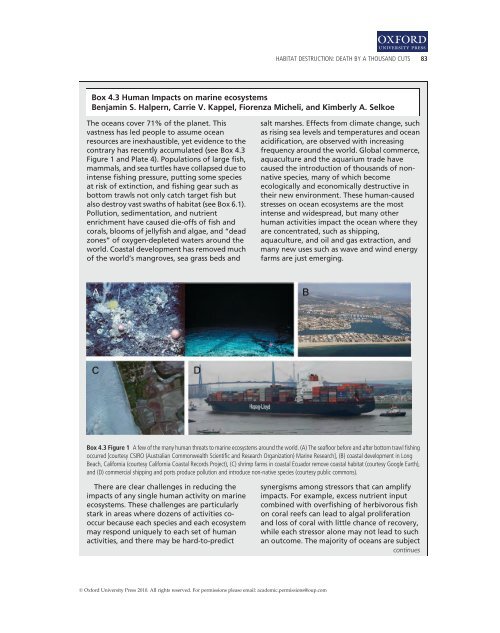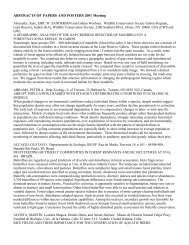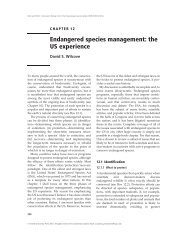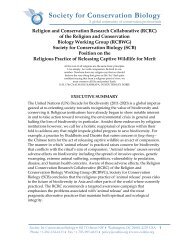Habitat Destruction: Death by a Thousand Cuts - Society for ...
Habitat Destruction: Death by a Thousand Cuts - Society for ...
Habitat Destruction: Death by a Thousand Cuts - Society for ...
- No tags were found...
You also want an ePaper? Increase the reach of your titles
YUMPU automatically turns print PDFs into web optimized ePapers that Google loves.
1<br />
HABITAT DESTRUCTION: DEATH BY A THOUSAND CUTS 83<br />
Box 4.3 Human Impacts on marine ecosystems<br />
Benjamin S. Halpern, Carrie V. Kappel, Fiorenza Micheli, and Kimberly A. Selkoe<br />
The oceans cover 71% of the planet. This<br />
vastness has led people to assume ocean<br />
resources are inexhaustible, yet evidence to the<br />
contrary has recently accumulated (see Box 4.3<br />
Figure 1 and Plate 4). Populations of large fish,<br />
mammals, and sea turtles have collapsed due to<br />
intense fishing pressure, putting some species<br />
at risk of extinction, and fishing gear such as<br />
bottom trawls not only catch target fish but<br />
also destroy vast swaths of habitat (see Box 6.1).<br />
Pollution, sedimentation, and nutrient<br />
enrichment have caused die‐offs of fish and<br />
corals, blooms of jellyfish and algae, and “dead<br />
zones” of oxygen‐depleted waters around the<br />
world. Coastal development has removed much<br />
of the world’s mangroves, sea grass beds and<br />
salt marshes. Effects from climate change, such<br />
as rising sea levels and temperatures and ocean<br />
acidification, are observed with increasing<br />
frequency around the world. Global commerce,<br />
aquaculture and the aquarium trade have<br />
caused the introduction of thousands of nonnative<br />
species, many of which become<br />
ecologically and economically destructive in<br />
their new environment. These human‐caused<br />
stresses on ocean ecosystems are the most<br />
intense and widespread, but many other<br />
human activities impact the ocean where they<br />
are concentrated, such as shipping,<br />
aquaculture, and oil and gas extraction, and<br />
many new uses such as wave and wind energy<br />
farms are just emerging.<br />
Box 4.3 Figure 1 A few of the many human threats to marine ecosystems around the world. (A) The seafloor be<strong>for</strong>e and after bottom trawl fishing<br />
occurred [courtesy CSIRO (Australian Commonwealth Scientific and Research Organization) Marine Research], (B) coastal development in Long<br />
Beach, Cali<strong>for</strong>nia (courtesy Cali<strong>for</strong>nia Coastal Records Project), (C) shrimp farms in coastal Ecuador remove coastal habitat (courtesy Google Earth),<br />
and (D) commercial shipping and ports produce pollution and introduce non‐native species (courtesy public commons).<br />
There are clear challenges in reducing the<br />
impacts of any single human activity on marine<br />
ecosystems. These challenges are particularly<br />
stark in areas where dozens of activities cooccur<br />
because each species and each ecosystem<br />
may respond uniquely to each set of human<br />
activities, and there may be hard‐to‐predict<br />
synergisms among stressors that can amplify<br />
impacts. For example, excess nutrient input<br />
combined with overfishing of herbivorous fish<br />
on coral reefs can lead to algal proliferation<br />
and loss of coral with little chance of recovery,<br />
while each stressor alone may not lead to such<br />
an outcome. The majority of oceans are subject<br />
continues<br />
© Ox<strong>for</strong>d University Press 2010. All rights reserved. For permissions please email: academic.permissions@oup.com






